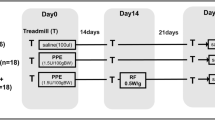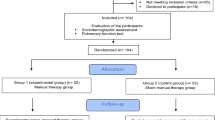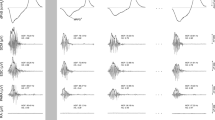Abstract
Thirteen tetraplegic patients were included in the study of the effects of respiratory muscle training and of electrical stimulation of the abdominal muscles on their respiratory capabilities. Each patient was subjected for three 1 month lasting periods of the study: for inspiratory muscle training, expiratory muscle training and for a period without training. The sequence of these three periods was random for each patient. Respiratory tests (RT) measuring forced vital capacity (FVC) and forced expiratory volume in one second (FEV1) were conducted before and following each monthly period. Measurements were taken under four sets of conditions: the patients' unassisted efforts, their efforts combined with pressure manually applied by a therapist to the upper part of their abdomen, and their efforts accompanied by electrical stimulation (ES) of the abdominal muscles during the early phase of expirium, once triggered by the therapist and once by the patients themselves. RT values were increased following respiratory muscle training and inspiratory training apparently had a slightly greater effect than its expiratory counterpart. The increments of values of RT were statistically significant (P<0.05) after the inspiratory muscle training. RT measurements were greater when the patient's voluntary effort was combined with ES of abdominal muscles than when it was not. This study concludes that respiratory muscle training is a potentially effective approach and that ES of the abdominal muscles has potentials to improve coughing in tetraplegic patients.
Similar content being viewed by others
Log in or create a free account to read this content
Gain free access to this article, as well as selected content from this journal and more on nature.com
or
Author information
Authors and Affiliations
Rights and permissions
About this article
Cite this article
Zupan, A., Šavrin, R., Erjavec, T. et al. Effects of respiratory muscle training and electrical stimulation of abdominal muscles on respiratory capabilities in tetraplegic patients. Spinal Cord 35, 540–545 (1997). https://doi.org/10.1038/sj.sc.3100433
Issue date:
DOI: https://doi.org/10.1038/sj.sc.3100433
Keywords
This article is cited by
-
Abdominal functional electrical stimulation to improve respiratory function after spinal cord injury: a systematic review and meta-analysis
Spinal Cord (2016)
-
A systematic review and meta-analysis of the effects of respiratory muscle training on pulmonary function in tetraplegia
Spinal Cord (2014)
-
Electromyographic signal-activated functional electrical stimulation of abdominal muscles: the effect on pulmonary function in patients with tetraplegia
Spinal Cord (2007)
-
Electrical stimulation of abdominal muscles for control of blood pressure and augmentation of cough in a C3/4 level tetraplegic
Spinal Cord (2002)



